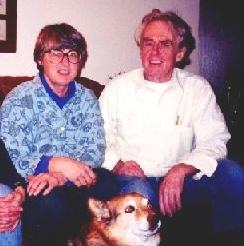Putting "The Fight" Into Perspective
Louise Allen were living their dream. Frank toiled for over 35 years as a union electrician and saved up enough to build a house on a remote island, accessible only by boat. For the past few years, Frank and Louise enjoyed the peace and solitude on one of San Juan Islands near Anacortes, Washington. He and Louise were living a very health lifestyle. They exercised regularly. Their diet was rich in fruits, nuts and vegetables. They were about as close to "living in harmony with nature" as you can reasonably get these days. Frank was 67 in mortal years, but half that in spirit and strength.
In November of 1996, Frank began feeling short of breath. He noticed a sharp pain in his right mid back and shoulder. Over time he thought the pain was serious enough to visit the emergency room. His doctors thought he had pneumonia. On November 22, 1996, a CT examination of the chest showed a broad area of pleural thickening in the right upper lateral chest with a moderate pleural effusion. Dr. Michael Sible of the Island Care Center in Anacortes, Washington, recommended a biopsy. A thoracentesis was performed on December 4, 1996. The pathologist found evidence of mesothelioma and adenocarcinoma. To be sure, the local doctors sought an opinion from another pathologist in Seattle (Harborview Medical Center), who used an electron microscope and special staining to confirm the diagnosis of malignant mesothelioma. The diagnosis was later confirmed by Dr. Sam Hammar, who reviewed slides and blocks. Dr. Hammar also found bilateral pleural plaques. He favored sarcomatoid over epithelial mesothelioma.
Frank was advised that he was not a candidate for surgery. He was prescribe morphine and Roxicet. Frank's oncologist referred Frank to another oncologist, Dr. Paul Weiden of the Virginia Mason Medical Center in Seattle. Dr. Weiden did not recommend the extrapleural pneumonectomy, a procedure which Virginia Mason had discontinued. Dr. Weiden recommended a cisplatin based chemotherapy approach at the outset with a "second line" regimen consisting of carboplatin and taxol, followed by a "flyer" or newer agent, such as gemcitabine. Virginia Mason had a phase II protocol using monoclonal antibodies, but Dr. Weiden regarded this option as something for later on "down the road." On January 20, 1997, after consulting with his wife and reading as much medical literature as he could on the subject, Frank agreed to utilize the carboplatin and Taxol chemotherapy.
After completing the first cycle of chemotherapy, Frank and Louise again visited Dr. Weiden. Frank experienced very few side effects at first. He experienced some fatigue a few days after starting his chemotherapy. At this point, Mr. Allen felt that the pain and the night sweats were becoming more tolerable. They reviewed his medication: four (4) Roxicet daily, Peri-Colace, Senokot and MS Contin. Dr. Weiden recommended Mr. Allen continue the MS Contin every twelve (12) hours to decrease his Roxicet. His pain was becoming less severe and more manageable. Mr. Allen returned on February 11, 1997 for his second round of chemotherapy. He also experienced some nausea in the second round. But his pain was less severe. He had more energy. He was able to visit with his children and grandchildren.
Over the last five years Frank had accomplished a serenity of which we can only dream. He had been in touch with nature, living each day with the elements of the land and the sea. On March 20, 1997, in a room full of lawyers, I took Frank Allen's deposition. As an attorney, I am steeped in the metaphor of warfare. We speak of ripping our adversaries apart, knocking them to their knees, busting their chops.
I asked Frank if he was, "... going to fight the tumor with every fiber of muscle in his body?" I knew, the second he looked me in the eye, that I had asked the wrong question. "I have this condition," he said, without drama, " and it's something that I produced in my own body, with the help of a little asbestos chip here and there, and `fighting' might not be the right way to do it. Maybe the way to do it is accept it and work on eliminating it from my body...."
I often think about Frank's answer. He did not surrender to the tumor. He acknowledged that getting mad is not the answer, either. He understood that the best offense perhaps is a strong immune system emboldened by a positive spirit.
On May 30, 1997, Frank Allen's body could no longer co-exist with the proliferating mesothelial cancer cells. A few "asbestos chips here and there" took away yet another man of tremendous dignity.
*** POSTED AUGUST 20, 1997 ***

